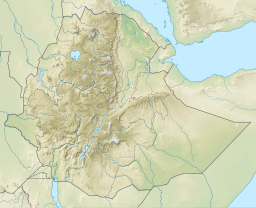| Lake Tana | |
|---|---|
 West-looking photograph of Lake Tana from space (April 1991) | |
| Location | East Africa |
| Coordinates | 12°0′N 37°15′E / 12.000°N 37.250°E |
| Primary inflows | Gilgel Abay, Kilti River, Magech River, Reb River, Gumara River |
| Primary outflows | Blue Nile |
| Basin countries | Ethiopia |
| Max. length | 84 km (52 mi) |
| Max. width | 66 km (41 mi) |
| Surface area | 3,200 km2 (1,200 sq mi) |
| Max. depth | 15 m (49 ft) |
| Surface elevation | 1,788 m (5,866 ft) |
| Islands | The most important are Tana Qirqos, Daga Island, Dek Island, and Mitraha |
| Settlements | Bahir Dar, Gorgora |
Lake Tana (Amharic: ጣና ሐይቅ, romanized: T’ana ḥāyik’i; previously Tsana[1]) is the largest lake in Ethiopia and a source of the Blue Nile. Located in Amhara Region in the north-western Ethiopian Highlands, the lake is approximately 84 kilometres (52 miles) long and 66 kilometres (41 miles) wide, with a maximum depth of 15 metres (49 feet),[2] and an elevation of 1,788 metres (5,866 feet).[3] Lake Tana is fed by the Gilgel Abay, Reb and Gumara rivers. Its surface area ranges from 3,000 to 3,500 square kilometres (1,200 to 1,400 square miles), depending on season and rainfall. The lake level has been regulated since the construction of the control weir where the lake discharges into the Blue Nile. This controls the flow to the Blue Nile Falls (Tis Abbai) and hydro-power station.
In 2015, the Lake Tana region was nominated as a UNESCO Biosphere Reserve recognizing its national and international natural and cultural importance.[4]
- ^ Garstin & Cana 1911.
- ^ Statistical Abstract of Ethiopia. 1967–68.
- ^ "Lake Tana, source of the Blue Nile". Observing the Earth. European Space Agency. 5 November 2004. Retrieved 4 November 2013.
- ^ Homepage of Lake Tana Biosphere Reserve
